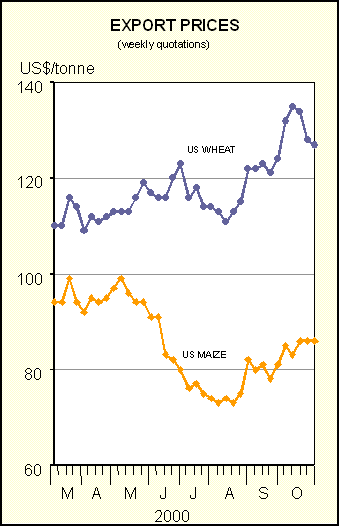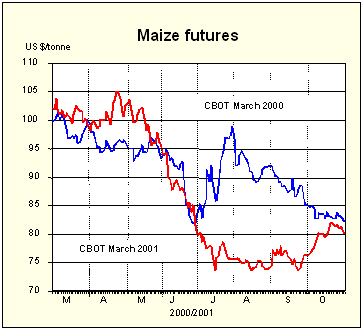


International wheat prices have risen since August. The increase in higher quality categories has been most pronounced with US wheat No. 2 (HRW, fob) averaging US$131 per tonne in October, up US$16 per tonne from August and also US$20 per tonne more than in the corresponding period in 1999. Strong import demand has provided most of the support for higher wheat prices in view of a decline in world output and prospects for lower stocks, which has proved supportive to prices also in the futures market. While by late October, the March 2001 wheat futures for soft red winter at the Chicago Board of Trade (CBOT) was quoted at close to last year's level of around US$100 per tonne, wheat futures showed some strength in October, rising above last year's values for the first time since the start of the season. Although indications for wheat prices over the next month or two continue to favour higher levels, the worst of the price slump from the exporters perspective may not be over as supplies of new crops from Australia and Argentina entering the market could renew the downward pressure on prices. However, because of reduced stocks, the size of planting for next season will play even more important role in determining which direction prices will take next season.

International maize prices have also strengthened since August, reflecting strong import demand, amid lower global production and reduced stocks, especially in the major exporting countries and in China. In October, the price of US No. 2 maize (fob) averaged US$92 per tonne, which was up US$16 per tonne from August and US$8 per tonne above the corresponding period last year. The continuing large exportable supplies are the main reason for the more subdued rise in maize prices since last year.
| 2000 | 1999 | ||
| Oct. | Aug. | Oct. | |
| (. . . . . . US$/tonne . . . . . .) | |||
| United States | |||
| Wheat 1/ | 131 | 115 | 111 |
| Maize | 85 | 76 | 95 |
| Sorghum | 92 | 76 | 84 |
| Argentina 2/ | |||
| Wheat | 123 | 111 | 112 |
| Maize | 76 | 74 | 90 |
| Thailand 2/ | |||
| Rice white 3/ | 191 | 189 | 220 |
| Rice, broken 4/ | 136 | 143 | 170 |
Source: FAO, see Appendix Table A.6
* Prices refer to the monthly average.
1/ No. 2 Hard Winter (Ordinary Protein).
2/ Indicative traded prices.
3/ 100% second grade, f.o.b. Bangkok.
4/ A1 super, f.o.b. Bangkok.
In the futures market, maize prices have remained below last year's values although the gap has narrowed considerably in recent weeks. However, the future price direction remains uncertain. On one hand, any immediate downside could be ruled out because of continuing strong import demand. Also, smaller exportable supplies in China and Hungary may prove supportive to prices. On the other hand, however, this year's expected record crop in the United States, the world's largest producer and exporter of maize, combined with abundant feed quality wheat in international markets, which could be imported as a substitute for maize, leads us to reiterate the earlier expectation that, although maize prices this season may rise slightly, they are, nonetheless, likely to remain relatively weak.
The FAO Export Price Index for Rice (1982-84=100) rose by 1 point in October to an average of 95 points after falling since the beginning of the year. However, it remains close to the lowest level in ten years. The recent slight recovery reflects some limited strengthening of prices for high quality rice, while lower quality grades remain under downward pressure.
Between August and October, the price of high quality Thai 100% B rice increased by US$2 per tonne to US$191 per tonne in response to the announcement of new sale contracts. Prices of high quality US No. 2/4 percent broken rice also recovered, and averaged US$291 per tonne in October, up US$31 per tonne from August, but still US$19 per tonne down compared to a year ago. The recent recovery in US prices was mainly supported by the call of new tenders to meet food aid commitments.


By contrast, the price of the lower quality fully broken rice (Thai A1 Super) dropped to US$136 per tonne in October, after remaining stable at about US$142-143 per tonne between July and September. This latest slide, drove down prices in October to the lowest level in 13 years, which has led major exporters to consider taking steps to prevent prices from deteriorating further. In that connection, Thailand and Vietnam signed, in September, an agreement to jointly market low grade rice in an attempt to prevent each from undercutting the other's prices in international transactions. China (Mainland) is considering joining the initiative.
International rice prices are expected to remain weak in the coming months. Additional downward pressure on prices might even be exerted by the arrival of new crop supplies on the market.